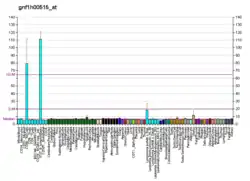GNGT2
Guanine nucleotide-binding protein G(I)/G(S)/G(O) subunit gamma-T2 is a protein that in humans is encoded by the GNGT2 gene.[5][6]
| GNGT2 | |||||||||||||||||||||||||
|---|---|---|---|---|---|---|---|---|---|---|---|---|---|---|---|---|---|---|---|---|---|---|---|---|---|
| Identifiers | |||||||||||||||||||||||||
| Aliases | GNGT2, G-GAMMA-8, G-GAMMA-C, GNG8, GNG9, GNGT8, G protein subunit gamma transducin 2 | ||||||||||||||||||||||||
| External IDs | OMIM: 139391 MGI: 893584 HomoloGene: 11325 GeneCards: GNGT2 | ||||||||||||||||||||||||
| |||||||||||||||||||||||||
| |||||||||||||||||||||||||
| |||||||||||||||||||||||||
| |||||||||||||||||||||||||
| Orthologs | |||||||||||||||||||||||||
| Species | Human | Mouse | |||||||||||||||||||||||
| Entrez | |||||||||||||||||||||||||
| Ensembl | |||||||||||||||||||||||||
| UniProt | |||||||||||||||||||||||||
| RefSeq (mRNA) | |||||||||||||||||||||||||
| RefSeq (protein) | |||||||||||||||||||||||||
| Location (UCSC) | Chr 17: 49.2 – 49.21 Mb | Chr 11: 95.84 – 95.85 Mb | |||||||||||||||||||||||
| PubMed search | [3] | [4] | |||||||||||||||||||||||
| Wikidata | |||||||||||||||||||||||||
| |||||||||||||||||||||||||
Phototransduction in rod and cone photoreceptors is regulated by groups of signaling proteins. The encoded protein is thought to play a crucial role in cone phototransduction. It belongs to the G protein gamma family and localized specifically in cones. There is evidence for use of multiple polyadenylation sites by this gene.[6]
References
- GRCh38: Ensembl release 89: ENSG00000167083 - Ensembl, May 2017
- GRCm38: Ensembl release 89: ENSMUSG00000038811 - Ensembl, May 2017
- "Human PubMed Reference:". National Center for Biotechnology Information, U.S. National Library of Medicine.
- "Mouse PubMed Reference:". National Center for Biotechnology Information, U.S. National Library of Medicine.
- Ong OC, Hu K, Rong H, Lee RH, Fung BK (Nov 1997). "Gene structure and chromosome localization of the G gamma c subunit of human cone G-protein (GNGT2)". Genomics. 44 (1): 101–9. doi:10.1006/geno.1997.4814. PMID 9286705.
- "Entrez Gene: GNGT2 guanine nucleotide binding protein (G protein), gamma transducing activity polypeptide 2".
Further reading
- Cohen NA, Sha Q, Makhina EN, et al. (1997). "Inhibition of an inward rectifier potassium channel (Kir2.3) by G-protein betagamma subunits". J. Biol. Chem. 271 (50): 32301–5. doi:10.1074/jbc.271.50.32301. PMID 8943291.
- Huang CL, Jan YN, Jan LY (1997). "Binding of the G protein betagamma subunit to multiple regions of G protein-gated inward-rectifying K+ channels". FEBS Lett. 405 (3): 291–8. doi:10.1016/S0014-5793(97)00197-X. PMID 9108307. S2CID 44072628.
- Cook LA, Schey KL, Cleator JH, et al. (2002). "Identification of a region in G protein γ subunits conserved across species but hypervariable among subunit isoforms". Protein Sci. 10 (12): 2548–55. doi:10.1110/ps.ps.26401. PMC 2374038. PMID 11714923.
- Strausberg RL, Feingold EA, Grouse LH, et al. (2003). "Generation and initial analysis of more than 15,000 full-length human and mouse cDNA sequences". Proc. Natl. Acad. Sci. U.S.A. 99 (26): 16899–903. doi:10.1073/pnas.242603899. PMC 139241. PMID 12477932.
- Cuello F, Schulze RA, Heemeyer F, et al. (2003). "Activation of heterotrimeric G proteins by a high energy phosphate transfer via nucleoside diphosphate kinase (NDPK) B and Gbeta subunits. Complex formation of NDPK B with Gbeta gamma dimers and phosphorylation of His-266 IN Gbeta". J. Biol. Chem. 278 (9): 7220–6. doi:10.1074/jbc.M210304200. PMID 12486123.
- Ivanina T, Rishal I, Varon D, et al. (2003). "Mapping the Gbetagamma-binding sites in GIRK1 and GIRK2 subunits of the G protein-activated K+ channel". J. Biol. Chem. 278 (31): 29174–83. doi:10.1074/jbc.M304518200. PMID 12743112.
- Gerhard DS, Wagner L, Feingold EA, et al. (2004). "The Status, Quality, and Expansion of the NIH Full-Length cDNA Project: The Mammalian Gene Collection (MGC)". Genome Res. 14 (10B): 2121–7. doi:10.1101/gr.2596504. PMC 528928. PMID 15489334.
- DePuy SD, Yao J, Hu C, et al. (2006). "The molecular basis for T-type Ca2+ channel inhibition by G protein β2γ2 subunits". Proc. Natl. Acad. Sci. U.S.A. 103 (39): 14590–5. doi:10.1073/pnas.0603945103. PMC 1600004. PMID 16973746.
This article is issued from Wikipedia. The text is licensed under Creative Commons - Attribution - Sharealike. Additional terms may apply for the media files.




